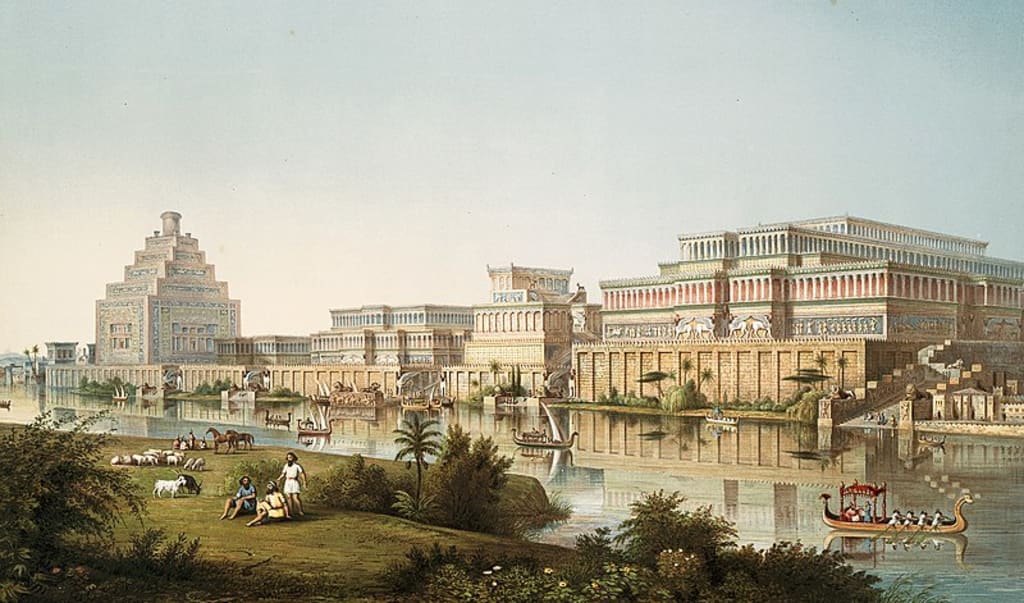What Was the Exact Location of the Hanging Gardens of Babylon?
One of the ancient world's wonders may have been misidentified.

One of the Seven Wonders of the Ancient World, the Hanging Gardens of Babylon, has been lost to the sands of time. Scholars from all over the world were awestruck by its beauty.
What if the Hanging Gardens wasn’t in the city of Babylon?
According to ancient texts, Nebuchadnezzar II, ruler of the Neo-Babylonian Empire (from 605 to 562 B.C.), constructed the garden. However, Nebuchadnezzar, who left extensive records of his rule, does not mention building a world-class garden.
Don’t you think this is strange? Why would a king who was meticulous in documenting his reign omit such a remarkable engineering feat? What makes the matter murkier is none of the Babylonian texts mention anything about a garden.
Archaeologists tried to solve this mystery of the missing Hanging Gardens of Babylon. To their surprise, they found no evidence of the gardens as described in the literature.
So the garden was a work of poetic imagination, right?
Not quite.
The gardens existed, just not where we thought them to be. Yet many historians still associate the Hanging Gardens with Babylon and Nebuchadnezzar. Let’s find out who built the garden and where it’s really located.
Fortunately, we don’t need to leave Mesopotamia in order to solve this puzzle. But before we talk about who built this ancient wonder, let us discuss what do the sources say about the Hanging Gardens of Babylon.
What do we know about the Hanging Gardens of Babylon?

In this palace he erected very high walls, supported by stone pillars; and by planting what was called a pensile paradise, and replenishing it with all sorts of trees, he rendered the prospect an exact resemblance of a mountainous country. This he did to gratify his queen, because she had been brought up in Media, and was fond of a mountainous situation- Berossus.
Berossus, a Babylonian high priest of the deity Marduk, wrote the first description of the Hanging Gardens in 290 BC. Later, Roman historians such as Josephus, Quintus Rufus, and Strabo cite Berossus as the primary source of information about the gardens.
Berossus claims Nebuchadnezzar built the garden for his queen Amytis. He describes the garden as a tiered square building with solid brick walls.
The garden had waterfalls and imported exotic trees such as cedar, cypress, ebony, walnut, pine, willow, and rosewood. It bloomed with flowers and fruits like quince, pomegranate, and plum.
Strabo mentions sophisticated screws that transport water from the Euphrates River to the gardens for watering the plants. The Babylonian kings loved to gather exotic creatures, and they kept them in the palace gardens.
The issue with these accounts of the Hanging Gardens of Babylon is that there is no archaeological evidence to support the claims.
In addition, Nebuchadnezzar makes no mention of his construction of the Hanging Gardens. The Babylonian ruler kept detailed records of everything he built, even the names of the streets in Babylon.
Why would he not mention such an enormous project?
Many centuries after Nebuchadnezzar’s reign, authors who had no connection to the city penned the tales of Babylon’s gardens. They didn’t have any knowledge of horticulture or engineering.
Archaeological evidence uncovered along the Euphrates’ banks does not support the existence of a spectacular multi-level garden with terraces watered by a complicated irrigation system.
Were the Greek and Roman authors creating a fantasy rendition of an ideal eastern garden? Before we discount the tales of ancient historians as fiction, let us head north to the modern-day Iraqi city of Mosul.
On the outskirts of Mosul lies Nineveh. It was the powerful Neo-Assyrian Empire’s majestic capital. The Assyrians had a long tradition of collecting exotic animals and creating elaborate gardens. In Nineveh, there was a magnificent palace garden built by Emperor Sennacherib (ruled from 705 to 681 B.C.).
Who built the real Hanging Gardens?

The Mesopotamian civilization was famous for its canal networks and city gardens. So, how can we be certain that Sennacherib built the hanging gardens?
The first piece of evidence comes from the Neo-Assyrian Empire’s legacy of garden construction. Sargon II, Sennacherib’s father, built a lovely garden at Durr-Sharukkin, his new capital. The garden also served as a hunting place for the royals. It was the backdrop of a hill. There was a lake for boating, although it is unclear if it was within or beyond the city walls.
Sennacherib continued his father’s legacy by documenting the splendor of his new garden at Nineveh in meticulous detail. The screws designed to convey water to the trees provide the finest evidence for the garden. They were an early version of the Archimedes screw, which was employed to transport water in the Greco-Roman era.
This is in line with the descriptions of the gardens given by later sources. Though we don’t know a lot about how these screws worked, it’s clear that they helped move water to plants on the artificially raised slopes of the garden.
Sennacherib himself said that this garden was a “wonder for all people.” He used water engineering that was ahead of its time, and that must have made the garden famous in the ancient world.
Sennacherib’s grandson Ashurbanipal, the most famous ruler of the Neo Assyrian Empire, is seen dining in this garden along with his wife. Ashurbanipal ruled the Neo-Assyrian Empire from 668 to 631 B.C.
Archaeological evidence from Nineveh supports the theory of a magnificent palace garden.
Now that I think about it, how did everyone get so mixed up about where the gardens were? Why aren’t they better known as the Hanging Gardens of Nineveh?
Why isn’t Sennacherib given credit for its construction?
Why was there confusion in identifying the real Hanging Gardens?
There might be several reasons why ancient writers misidentified the real Hanging Gardens of Nineveh with a supposed one in Babylon. Most of them, like Roman authors, relied on the works of Greek historians. The Greeks relied on Berossus, a Babylonian source. Because the Babylonians were bitter rivals of the Assyrians, it’s possible that they weren’t inclined to give credit where credit was due.
Classical texts often mix up Babylon with Nineveh. Quintus Curtius Rufus was the first Roman writer to identify an Assyrian king as the builder of the Hanging Gardens. But even he acknowledges the location of the gardens was in Babylon.
Another source of confusion might be the Hebrew Bible’s mistaken identification of king Sennacherib with Nebuchadnezzar.
Both Sennacherib and Nebuchadnezzar had sacked Jerusalem and burned it to the ground. Jewish sources frequently mix up the two. We can see this in the Book of Judith, which says that Nebuchadnezzar was the king of the Assyrians and that he ruled from Nineveh. He was a Babylonian king, and he reigned from Babylon.
Why did so many authors mix up Nineveh in Northern Mesopotamia with Babylon, in the country’s south? For this, we need to figure out what “Babylon” means. It translates to “God’s Gate.” Sennacherib named the gates of Nineveh after the gods. This might mean that Sennacherib wanted his city to be called Babylon, too.
We can find another important clue in Arabic sources on astronomy. The latitude of “Old Babylon” was used to determine the longest day of the year. This latitude does not pass via Babylon but through Nineveh.
There was a lot of confusion about which city people were talking about when they used the word “Babylon” in the past.
A few things are obvious to us regarding the Hanging Gardens of Babylon. Nebuchadnezzar did not build it, Sennacherib did. It was not in Babylon but in Nineveh. The sources who discussed the stories may have misidentified the true builders and the city.
Maybe it’s time we settle the dispute on the controversial location of one of the ancient wonders of the world in favor of Sennacherib and the Assyrians.
Should it be named the Hanging Gardens of Nineveh?






Comments
There are no comments for this story
Be the first to respond and start the conversation.